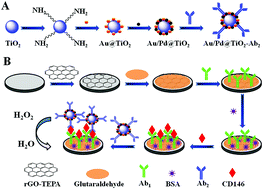An ultrasensitive electrochemical immunosensor for the detection of CD146 based on TiO2 colloidal sphere laden Au/Pd nanoparticles
Abstract
An ultrasensitive electrochemical immunosensor for the detection of cluster of differentiation 146 antigen (CD146) based on TiO2 colloidal sphere laden Au/Pd nanoparticles (Au/Pd@TiO2) was developed. In this work, reduced graphene oxide-tetraethylene pentamine (rGO-TEPA) was applied as an electrode modifying material to modify the surface of a glassy carbon electrode (GCE). Au/Pd@TiO2 was used as the secondary-antibody (Ab2) label for the fabrication of the immunosensor. Amperometric response of the immunosensor for electrocatalytic reduction of hydrogen peroxide (H2O2) was recorded. Electrochemical impedance spectroscopy (EIS) proved that fabrication of the immunosensor was successful. The anti-CD146 primary antibody (Ab1) was immobilized on the rGO-TEPA modified GCE by a cross-linking reagent of glutaraldehyde (GA). With Ab1 immobilized onto the rGO-TEPA modified GCE and Ab2 linked with Au/Pd@TiO2, the immunosensor displayed a wide linear range (0.0050–20 ng mL−1), a low detection limit (1.6 pg mL−1), good reproducibility, good selectivity and acceptable stability. The designed sensing strategy may provide a potential application in the detection of other tumor markers.


 Please wait while we load your content...
Please wait while we load your content...